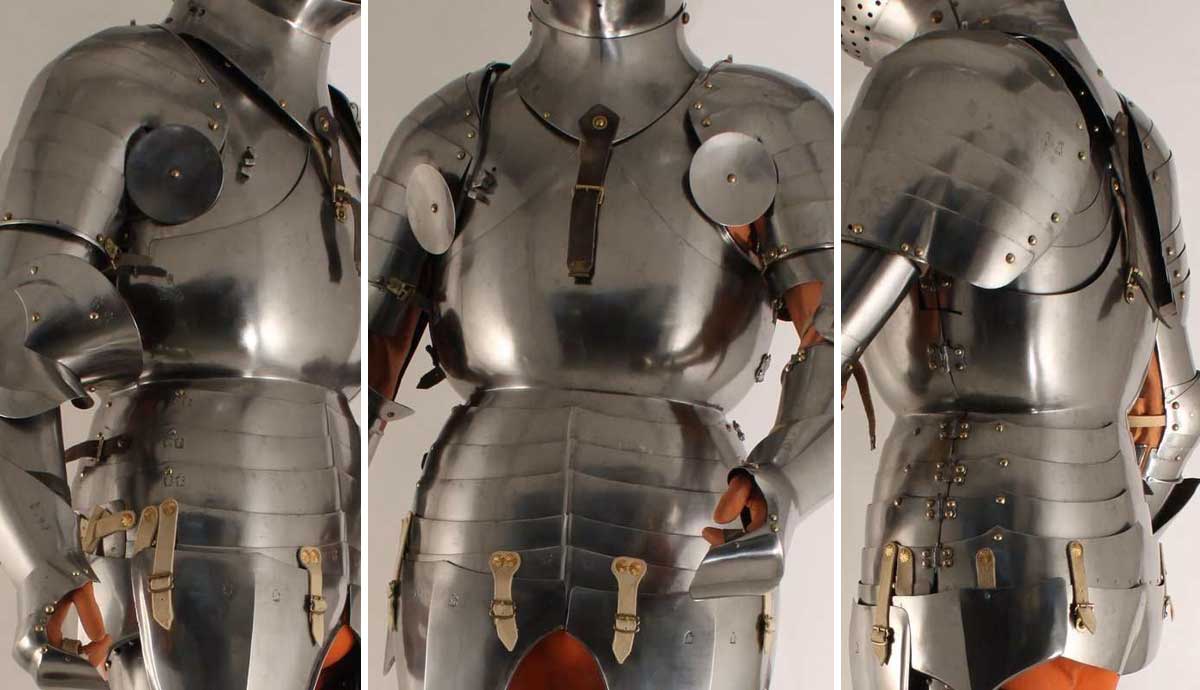 Harness WS A2 in Vienna once belonging to Friedrich I, Elector of Palatine. Images taken from thesis of Matthias Goll.
Harness WS A2 in Vienna once belonging to Friedrich I, Elector of Palatine. Images taken from thesis of Matthias Goll.
The decision to commission a new harness was finally made real in January 2015. It was important that it be as historically accurate as possible without having to pawn all of the wife’s heirlooms. It was also hoped to reproduce a complete harness rather than a composite one that had been assembled from multiple decades. That greatly reduced the number of options available. In the end, the best choice was the harness once owned by Friedrich I, Kurfürst von der Pfalz, often referred to as Frederick the Victorious. Born in 1425 at Heidelberg, he was the son of Louis III, Elector Palatine.
Friedrich (1 August 1425, Heidelberg– 12 December 1476, Heidelberg) earned the surname “the Victorious” (der Siegreiche) shortly after he came to rule as regent for his nephew, Philip, after the death of his older brother in 1451, claiming to be the legitimate elector. The Emperor Frederick III refused to confirm his status as his actions violated imperial law. Friedrich, an able strategist, quickly allied himself with the Duke of Bavaria, and the emperor was unable to remove him. Through a series of subsequent encounters, Friedrich won against members of the emperor’s party such as the Elector of Brandenburg and archbishop of Mainz, which served to increase his territory. At the Battle of Seckenheim, Friedrich captured the bishop of Baden, Margrave of Baden-Baden and count of Wurttemberg.
Friedrich’s surviving armour was made for him by Tomasso Missaglia around the year 1450. It is currently on display in the Kunsthistorisches Museum in Vienna, Austria, and is in an almost perfect state of preservation—it is only missing its guardbrace (reinforcing plate over the left elbow) and gauntlets. The armour features the smooth and rounded surfaces characteristic of the Italian style; a complex but very flexible backplate; light pauldrons at the shoulders that lack reinforcing plates, and a deep fauld ending in shallow-pointed tassets. The fact that it was a Milanese export armour made in a French style for a German client made it a very cosmopolitan choice for a Texan dreaming of being an English knight.
While there was armour production in late medieval England, primarily centered in London, it was relatively expensive as all of its steel had to be imported from Spain. Many lesser knights turned to imported armour, chiefly from Milan, which was one of Europe's largest producers of armour. Beginning with the Friedrich harness as a basis, a few stylistic modifications were recommended by Dr. Tobias Capwell, curator of arms and armour at the Wallace Collection in London and world-renown jouster. He recommended swapping out the great bascinet that Friedrich wore with an armet with reinforcing plate for jousting and perforated visor for the mêlée seemed more appropriate. Dr. Capwell suggested copying copying the armet in Zurich (LM 16807) also made by the Missaglia workshop during the same 1450-1455 timeframe. Finally, rather than the asymmetrical arms with larger left couter (elbow), Dr. Capwell thought the new harness should have symmetrical couters akin to the composite (BHM SBZ102) currently in the Historisches Museum, Bern, Switzerland, which would be in line with the English style of fighting on foot. They, too, were made in the Missaglia workshop around 1455.
